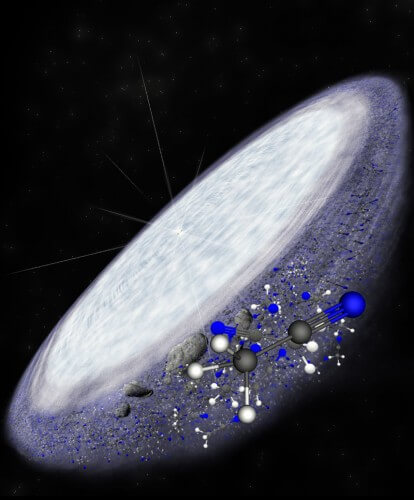For the first time, astronomers have succeeded in discovering the presence of complex organic molecules, the building blocks of life, in a protoplanetary disk surrounding a young star. The discovery strengthens the assumption that the conditions in the solar system are not unique in the universe

For the first time, astronomers have succeeded in discovering the presence of complex organic molecules, the building blocks of life, in a protoplanetary disk surrounding a young star. The discovery strengthens the assumption that the conditions in the solar system are not unique in the universe.
The discovery was made using the Atacama Large Millimeter/submillimeter Array (ALMA) and confirms that the conditions that made life possible on Earth are not unique in the universe. The findings were published in the April 9 issue of the journal Nature.
Alma's new observation reveals that the protoplanetary disk surrounding the young star MWC 480 contains large amounts of methyl cyanide (CH3CN) – a complex carbon-based molecule. There is enough methyl cyanide around MWC 480 to fill all of Earth's oceans.
This molecule and its simpler cousin - hydrogen cyanide (HCN) were also discovered in the cold regions around the fresh disk, in an area that astronomers believe is equivalent to the Kuiper belt - an area infested with dwarf planets and comets at the edge of the solar system beyond Neptune.
The comets remain the last remnants of the primordial chemistry of the solar system, from the time of the formation of the planets. Comets and asteroids from the outer solar system are the best candidates to seed the early Earth with water and organic molecules, thereby setting the stage for the development of early life.
"Studies of comets and asteroids have shown us that the planetary nebula from which the Sun and the planets were born was rich in water and complex organic compounds," says Karin Oberg, an astronomer at the Harvard-Smithsonian Center for Astrophysics in Cambridge, Massachusetts and the lead author of the paper.
"We now have even better evidence that the same chemistry exists elsewhere in the universe, in regions where a solar system different from our own may have formed. This is intriguing because the molecules found in MWC 480 are found in the same concentrations in comets in our solar system.
The star MWC 480, which is twice the diameter of the Sun, is 455 light-years away in the Taurus star formation region. It is a star about a million years old surrounded by a disk that is in the first stages of development. A dark nebula of dust and gas. Further research using ALMA and other telescopes will be required to detect signs of planet formation, although high-resolution observations may reveal signs similar to those of HL Tauri, a star of a similar age. Cyanide and in particular methyl cyanide are important because they contain oxygen and nitrogen bonds that are essential for the creation of amino acids, the basis of proteins and the building blocks of life.
Until now it was not clear whether these complex organic materials are common in the universe and can survive in the energetic environment of a solar system at the time of its formation, where shock waves and radiation can easily break chemical bonds.
Thanks to Alma's sensitivity, the scientists were able to see in these observations that these molecules not only survive, but even thrive. More importantly, the molecules Alma discovered are much more common in the protoplanetary nebula than in the interstellar cloud from which it formed. This indicates that the protoplanetary disk is very efficient in creating complex organic molecules and that it was able to create them in a short time.
The astronomers estimate that as the system continues to evolve, it is likely that these molecules, once safely locked inside comets and other icy bodies, can be transported to environments more friendly to life.
"From the study of planets outside the solar system, we know that the solar system is not unique in the number of planets and the distribution of water," Oberg says. "Now we know that it is not unique in organic chemistry. Again, we learn that we are not special. From the perspective of life in the universe, this is big news."
For information on the Southern European Observatory website

3 תגובות
NN - I love you!!!
Methyl cyanide *does* not contain a bond of oxygen and nitrogen as written.
Pretty